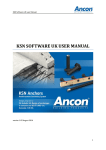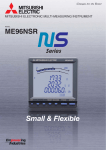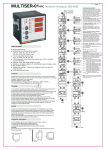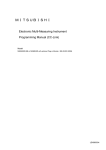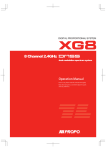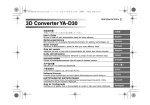Download ConcreteDesigner Bridge ConcreteDesigner Bridge
Transcript
www.eurocodesoftware.se ConcreteDesigner Bridge ConcreteDesigner Bridge designs reinforcement for concrete beams, with given section forces, according to EN 1992-1-1:2004 and national annexes. The program generates a report which includes both graphical and numerical results. The user can easily create a complete report to simplify the presentation to the client. User manual Rev: B Eurocode Software AB User manual brdEc210 1 2 General ............................................................................................................................... 4 1.1 Denotations .................................................................................................................. 5 1.2 Method ......................................................................................................................... 5 1.3 Step by step guide to ConcreteDesigner Bridge .......................................................... 6 1.4 Input files ..................................................................................................................... 6 1.4.1 [Section_forces].xml ............................................................................................ 6 1.4.2 [Input_file].xml .................................................................................................... 6 1.4.3 Handling and editing of files ................................................................................ 6 1.4.4 Use an existing input file ...................................................................................... 7 Basics ................................................................................................................................. 8 2.1 3 4 Buttons ......................................................................................................................... 8 File ...................................................................................................................................... 9 3.1 Project description ....................................................................................................... 9 3.2 Print selection ............................................................................................................ 10 Input ................................................................................................................................. 10 4.1 Basic input ................................................................................................................. 11 4.2 Material properties ..................................................................................................... 12 4.3 Cross section .............................................................................................................. 13 4.4 Cross section variations ............................................................................................. 15 4.5 Parameters ................................................................................................................. 16 4.5.1 4.6 5 ConcreteDesigner Bridge Find number of cycles for using Palmgren-Miner rule ...................................... 18 Rebar layers ............................................................................................................... 19 Section forces ................................................................................................................... 20 5.1 Copy sectional forces form Excel .............................................................................. 21 5.2 ULS ............................................................................................................................ 22 5.2.1 Bending .............................................................................................................. 22 5.2.2 Shear ................................................................................................................... 22 5.3 SLS ............................................................................................................................ 23 5.3.1 Crack control ...................................................................................................... 23 5.3.2 Crack width ........................................................................................................ 23 5.4 Fatigue ....................................................................................................................... 24 5.4.1 Bending .............................................................................................................. 25 5.4.2 Permanent Shear ................................................................................................. 26 5.5 Reduction over support .............................................................................................. 27 5.6 Shear design parameters ............................................................................................ 28 Z:\Programdokumentation\Användardokumentation\ConcreteDesignerBridge_EN_Rev_C.docx © Eurocode Software AB 8/22 /2013 9:40:00 AM User manual brdEc210 5.7 6 Read section forces .................................................................................................... 29 Results .............................................................................................................................. 30 6.1 Bending ...................................................................................................................... 30 6.1.1 Design forces ...................................................................................................... 30 6.1.2 Reinforcement .................................................................................................... 31 6.1.3 Reinforcement specification ............................................................................... 34 6.2 Shear .......................................................................................................................... 34 6.2.1 Design forces ...................................................................................................... 34 6.2.2 Reinforcement .................................................................................................... 36 6.3 Fatigue ....................................................................................................................... 38 6.3.1 7 8 ConcreteDesigner Bridge Fatigue bending reinforcement........................................................................... 38 6.4 Report ........................................................................................................................ 39 6.5 Reinforcement sketch ................................................................................................ 39 6.6 Print Selection............................................................................................................ 39 Help .................................................................................................................................. 40 7.1 About ......................................................................................................................... 40 7.2 Support....................................................................................................................... 40 How to read the report ...................................................................................................... 42 8.1 Notations used for material properties an sectional forces ........................................ 42 8.2 Longitudinal reinforcement ....................................................................................... 42 8.3 Shear reinforcement ................................................................................................... 43 8.4 Crack control and crack width ................................................................................... 43 8.5 Fatigue bending reinforcement and concrete ............................................................. 44 8.6 Fatigue shear .............................................................................................................. 45 Z:\Programdokumentation\Användardokumentation\ConcreteDesignerBridge_EN_Rev_C.docx © Eurocode Software AB 8/22 /2013 9:40:00 AM User manual brdEc210 ConcreteDesign Bridge Page 4(45)) 1 General After choosing result lines from BRIGADE the user can start the program ConcreteDesigner Bridge. The program calculates the required amount of reinforcement in ultimate and serviceability limit state and checks fatigue. It is also possible to let the program find the envelope of the needed reinforcement along an optional number of result lines. Operations Moment charts for the chosen lines Reduction of section forces over supports Calculation of necessary reinforcement with regard to ultimate and serviceability limit state Average of necessary reinforcement for a number of lines Display of arrangement of transverse reinforcement Automatic calculation and distribution of bending reinforcement in ultimate and serviceability limit state Check of fatigue of longitudinal (bending) reinforcement Choose which/how many sections will be presented in the numerical report The report includes: Moment graphs o ULS, max/min moment graph o SLS, max/min moment graph Necessary amount of reinforcement o ULS, bending and shear o SLS Amount of used reinforcement o Rebars for bending and shear Fatigue o Bending o Shear Reinforcement sketch o Reinforcement sketch in dxf-format Geometry, sectional forces and results are presented graphically. The charts show all sections from BRIGADE. This user manual describes the program by showing the methods used for calculations and a step by step guide on how to use the program. The manual also covers all operations in the program, based on where you find them in the menu. Z:\Programdokumentation\Användardokumentation\ConcreteDesignerBridge_EN_Rev_C.docx © Eurocode Software AB 8/22 /2013 9:40:00 AM User manual brdEc210 ConcreteDesign Bridge Page 5(45)) 1.1 Denotations Ec2 EN 1992-1: 2004, design of concrete structures EKS Eurocodes ULS Ultimate limit state SLS Serviceability limit state E Load effect Ed Design value of load effect R Resistance Rd Design value of resistance 1.2 Method The method used to design the reinforcement in a strip is described below. Design of a region/strip One or many result lines, longitudinal or transversal, are chosen for the region where section forces shall be calculated. This is done in BRIGADE. BRIGADE finds the design section forces of the reinforcement for the chosen result lines. The section forces are calculated either along or transverse the lines depending on the type of reinforcement is to be designed. BRIGADE creates a file containing the following information: o Coordinates and node numbers o Section geometry o Design section forces ConcreteDesigner Bridge reads the file and does the following: o Calculates the maximum load effect for every section of each line sends several max/min-values for the same point depending on how many load combinations have been chosen for the current result line. o Designs the reinforcement in ultimate and serviceability limit state for each result line. o Determines the amount of reinforcement needed with regard to fatigue. For each section, you may choose which type of graphs will be shown. o Single: ConcreteDesigner Bridge displays necessary reinforcement amount and utilization rate for each line o Average: Concrete Design Bridge displays the average values for multiple result lines. o Max/min: Concrete Design Bridge splays the max/min-values for multiple result lines. Z:\Programdokumentation\Användardokumentation\ConcreteDesignerBridge_EN_Rev_C.docx © Eurocode Software AB 8/22 /2013 9:40:00 AM User manual brdEc210 ConcreteDesign Bridge Page 6(45)) 1.3 Step by step guide to ConcreteDesigner Bridge 1. In BRIGADE, choose result lines in the region where you want to calculate the sectional forces, and perform the calculation. When the calculation is done you will be sent to ConcreteDesigner Bridge automatically. If you have done calculations with the same input data before, i.e. the same material, parameters and so on, but with different result lines, you can either choose to use the guide or proceed to chapter 1.4.4. 2. You are sent directly to the dialogue Read section forces. Do the necessary adjustments and proceed by clicking Next. See chapter 5.7 for more information. 1.4 Input files Input data files are created by BRIGADE and can thereafter be used by ConcreteDesigner Bridge 1.4.1 [Section_forces].xml Such a file is created every time you run BRIGADE. The file is created automatically and stored in the bdb-catalogue and contains sectional forces and geometry. 1.4.2 [Input_file].xml This file is created every time you save a file in ConcreteDesigner Bridge. This file contains material data for concrete and reinforcement steel, as well as arrangement of bending and shear reinforcement. In this file there is a connection to the corresponding [Section_forces].xml. 1.4.3 Handling and editing of files 1.4.3.1 Connection between [Section_forces].xml and [Input_file].xml For each combination of lines run in BRIGADE the file [Section_forces].xml is created. Z:\Programdokumentation\Användardokumentation\ConcreteDesignerBridge_EN_Rev_C.docx © Eurocode Software AB 8/22 /2013 9:40:00 AM User manual brdEc210 ConcreteDesign Bridge Page 7(45)) [Input_file].xml is created when you save your work in ConcreteDesigner Bridge for the first time. The file should be saved in the appropriate catalogue (for example the bdb-catalogue). Alternatively you can move all files regarding the design ([Section_forces].xml and [Input_file].xml) to a separate folder. In this case the connection between the two files must be edited in [Input_file].xml. This also applies if you change the name of the [Section_forces].xml file. Edit the connection by opening [Input_file].xml in Notepad, or a similar program, and change the path in: <File> <name>[Section_forces].xml </name> </File> As long as the files are placed in the same folder it is enough to refer to the name of the file, otherwise the entire path is needed. 1.4.3.2 Modification of input for each part Start the program brdEc210 (ConcreteDesigner Bridge). Open the input file [Input_file].xml. The program reads the section forces and geometry from [Section_forces].xml and other input from [Input_file].xml. Make your adjustments and save the input file [Input_file].xml with its modifications. You cannot save changes in geometry here, since the geometry is read from the file [Section_forces].xml. 1.4.4 Use an existing input file If you want to do multiple calculations in one project, with the same input but with different result lines and section forces, you can use the first input file you made, [Input_file].xml, as a template. Create a copy of the input file you want to use, [Input_file_copy].xml. Run a calculation to find sectional forces in BRIGADE. When ConcreteDesigner Bridge is opened just close it. Move the new file [Section_forces].xml to the folder where [Input_file_copy].xml is saved. Then change the connection between the files, see chapter 1.4.3.1, so that [Input_file_copy].xml directs to the new file with section forces. Open ConcreteDesigner Bridge and open [Input_file_copy].xml. The file now has the exact same settings as [Input_file].xml and you may proceed directly to the reinforcement arrangement, chapter 6.1.2.1 and 6.2.2.1. Z:\Programdokumentation\Användardokumentation\ConcreteDesignerBridge_EN_Rev_C.docx © Eurocode Software AB 8/22 /2013 9:40:00 AM User manual brdEc210 ConcreteDesign Bridge Page 8(45)) 2 Basics The function of the buttons in the start window is described here. The remaining functions are described in the following chapters. Figure 1 Start Red line centre of gravity line for the section Blue line total height of the beam, used to design the bottom reinforcement. 2.1 Buttons New Open input file Save input file Print Guide Read section forces Genera rebar location Bending reinforcement requirement Z:\Programdokumentation\Användardokumentation\ConcreteDesignerBridge_EN_Rev_C.docx © Eurocode Software AB 8/22 /2013 9:40:00 AM User manual brdEc210 ConcreteDesign Bridge Page 9(45)) Bygelarmering Armeringsskiss Stirrup 3 File Under File you can find the tools; New, Open, information, Save, Save as and Exit. Figure 2 File 3.1 Project description At Information it is possible to state which project it is, the location of the member, which appendix it is and a short description. This information will be printed in the report. Figure 3 Project description Z:\Programdokumentation\Användardokumentation\ConcreteDesignerBridge_EN_Rev_C.docx © Eurocode Software AB 8/22 /2013 9:40:00 AM User manual brdEc210 ConcreteDesign Bridge Page 10(45)) 3.2 Print selection Under Print selection you can choose which graphics will be included in the print. Figure 4 Print selection Numeric Number of sections to be presented between supports. Give a high value, for example 99, to include all sections. 4 Input Under the tab Input you find settings for material properties, geometry and other parameters. Figure 5 Input data Z:\Programdokumentation\Användardokumentation\ConcreteDesignerBridge_EN_Rev_C.docx © Eurocode Software AB 8/22 /2013 9:40:00 AM User manual brdEc210 ConcreteDesign Bridge Page 11(45)) 4.1 Basic input Figure 6 Basic input Varying geometry Check if the cross section varies, you can find x-coordinate, height and width for each section in the dialogue Cross section variations, see chapter 0 for further information. Number of sections Number of sections for sectional forces. Total length Total length of the designed member. Give Asl Check if you want to manually set the amount of longitudinal reinforcement used by the program to design the transverse reinforcement. Calc ki from geometry Check if you want the program to calculate the effect of variable height of the beam. Along result line Check if the sectional forces are taken along the result line. Used for calculating the rebar layers since the tensile force won’t be shifted if the sectional forces are taken perpendicular to the result line. Number of result lines Number of lines with calculated sectional forces. SLS: Crack control Sectional forces to control if the section is cracked. If not checked a control will be done for SLS sectional forces multiplied by 1.5. SLS: Crack width Sectional forces for design in serviceability limit state. ULS: Shear Sectional forces for design with regard to shear. Fatigue Sectional forces for design with regard to fatigue. Z:\Programdokumentation\Användardokumentation\ConcreteDesignerBridge_EN_Rev_C.docx © Eurocode Software AB 8/22 /2013 9:40:00 AM User manual brdEc210 ConcreteDesign Bridge Page 12(45)) 4.2 Material properties Figur 7 Material properties Partial factors for material Concrete property The user sets a concrete class according to Ec2, table 3.1. It is also possible to set a concrete class which is not predefined. Std, +NA(S), +NA(N), A couple of different national settings can be used in the design. In this version the user can choose between the following: Std Standard Eurocode +NA(S) EKS – Swedish national annex +NA(N) Norwegian national annex max fywd Designing the shear reinforcement the user can choose maximum yield stress for the reinforcement. Concrete nominal cover The program considers other parameters needed to calculate a sufficient concrete cover and minimum distance between longitudinal reinforcement. Stirrups are regarded when calculating concrete cover for beams. Maximum aggregate size Used when calculating the free distance between reinforcement bars in and between layers. Reinforcement Set type and diameter of reinforcement. Z:\Programdokumentation\Användardokumentation\ConcreteDesignerBridge_EN_Rev_C.docx © Eurocode Software AB 8/22 /2013 9:40:00 AM User manual brdEc210 ConcreteDesign Bridge The button: Page 13(45)) Environment: For environment dependent settings such as structural class and exposure class. Figur 8 Environment 4.3 Cross section If an input file from Brigade is used the geometry of the cross section will be imported automatically. Otherwise, this dialogue is used for constant cross-sections, if the cross-section varies insert data according to chapter 4.4. Figure 9 Cross section Type Type of cross-section chosen as one of the following, this choice governs which input data is to be given: 1=rectangular 2=T-section 3=L-section 4=_|_-section 5=O-section 6=I-section 7=slab strip bw=1000 8=Through shaped section Z:\Programdokumentation\Användardokumentation\ConcreteDesignerBridge_EN_Rev_C.docx © Eurocode Software AB 8/22 /2013 9:40:00 AM User manual brdEc210 ConcreteDesign Bridge Page 14(45)) 9=Special beam 10=I-section delta bf h total height of the beam bw width of the web b total width of the flange (including web width), if there is no flange set b=0. t flange thickness, if there is no flange set t=0. ts inclined length b t ts bw Z:\Programdokumentation\Användardokumentation\ConcreteDesignerBridge_EN_Rev_C.docx © Eurocode Software AB 8/22 /2013 9:40:00 AM User manual brdEc210 ConcreteDesign Bridge Page 15(45)) 4.4 Cross section variations Used for varying cross-sections. Input is imported automatically from Brigade but can be changed. Figure 10 Varaiation of cross section Xkrd x-coordinates, from left to right h, top Total height of the beam, used to design top reinforcement. h, bot Total height of the beam, used to design bottom reinforcement. Useful for design of reinforcement in haunched slabs bw web width Nexc Eccentricity of axial force, given from the top of the section positive upwards. Usually equal to –h/2. Support J- Support in the section N- No support in the section Used to identify supports for moment reduction over supports. Z:\Programdokumentation\Användardokumentation\ConcreteDesignerBridge_EN_Rev_C.docx © Eurocode Software AB 8/22 /2013 9:40:00 AM User manual brdEc210 ConcreteDesign Bridge Page 16(45)) 4.5 Parameters Figure 11 Parameters ULS: Stirrups: Alpha Angle of the stirrups, in the dialogue for reinforcement arrangement the user can define different stirrup angles for different parts of the beam. Legs Number of legs for stirrups. Diameter of the mandrel Bending diameter for shear reinforcement, used in fatigue control Anchorage length: al Shift of the tensile force graph is set to 1,2*d, alternatively calculated according to Ec2. lbd Check this box to set anchoring length to the basic value. Fatigue Choose a method for fatigue calculations: Method: NN.2 Road bridge NN.3 Railway bridge Palmgren-Miner rule Z:\Programdokumentation\Användardokumentation\ConcreteDesignerBridge_EN_Rev_C.docx © Eurocode Software AB 8/22 /2013 9:40:00 AM User manual brdEc210 ConcreteDesign Bridge Page 17(45)) Number of cycles Number of cycles, to find an appropriate number use chapter 4.5.1 if Palmgren-Miner rule is used Reduction for bent bars, stirrups Check if there are bent bars or stirrups SLS: Crack width: Maximum allowable crack widths, Top Maximum allowed crack width on top of the section. Maximum allowable crack widths, Bot Maximum allowed crack width on the bottom of the section. Crack control factor, Top Safety factor for cracking, ζ, at the top of the section, used when calculating fct,fl=k∙fctm/ζ. If ζ is set to zero the following equations will be used to find if the section is cracked: fct,eff=fctm, σc<fct,eff , pure bending σcn+σcm<fct,eff ,bending and axial forces Crack control factor, Bot Safety factor for cracking, ζ, at the bottom of the section.See above. Factor kt Factor considering the duration of load, 0,4 or 0,6. Final creep ratio, Ecd,eff=Ecd/(1+φeff). Creep factor Factors in Appendix NN Settings under Factors in Appendix NN depends on the type of bridge, railway or road. If it’s a road bridge a correctional factor for steel, λs, and one for concrete, λc, is set. For a railway bridge the correctional factor should also be multiplied by a dynamical factor, φ. If you chose to use Palmgren-Miner rule his section is not used. Lambda, c damage equivalent factor for concrete, see Ec2 Appendix NN equ. NN.101 Lambda, s damage equivalent factor for fatigue, steel, see Ec2 Appendix NN equ. NN.101 Lambda, c*fi damage equivalent factor for steel, λ, multiplied by a dynamical factor, φ. See Ec2 Appendix NN equ. NN.106. Lambda, s*fi damage equivalent factor for concrete, λ, multiplied by a dynamical factor, φ. See Ec2 Appendix NN equ. NN.106. Z:\Programdokumentation\Användardokumentation\ConcreteDesignerBridge_EN_Rev_C.docx © Eurocode Software AB 8/22 /2013 9:40:00 AM User manual brdEc210 ConcreteDesign Bridge Page 18(45)) 4.5.1 Find number of cycles for using Palmgren-Miner rule Palmgren-Miner is founded on finding the fatigue damage factor, DEd, for the steel. This factor is the sum of the number of loading cycles during the life of the structure divided by the resisting number of load cycles during the same time. Thus, the condition is that DEd should be less than one. ∑ where Ec2 6.8.4(2), equation 6.70 is the applied number of cycles for the stress range is the resisting number of cycles for the stress range N is given by the Wöhler graph, figure 6.30 Ec2. Table 6.3N gives the values of σRSK, k2, and N*. The factor γs is set to 1,15. σRSK is the resisting stress range of the reinforcement. Tabell 1 Resisting stress of reinforcment σRSK [MPa] 162,5 k2 9 N* 106 γs 1,15 N( σi) can then be found in figure 6.30 using the stress, σ, for each axle load. The stress is assumed to vary linearly with the applied load. The stress is set for one of the axle loads, for example 4x140 kN, and gives the stress for the rest of the axle loads. n( σi) is divided by N( σi) for each axle load and the quotients are summed up. If the sum is less than one the reinforcement capacity is large enough, if it isn’t the amount of reinforcement has to be increased. ∑ Ec2, equation 6.70 If the fatigue damage factor, DEd, does not satisfy the condition the value of σ140 has to be adjusted until the fatigue damage factor is less than 1. Now, when the value of DEd is less than one, it’s the value of N( σi) for the stress given by 4x140 kN that is the input value that can be used in the box Number of cycles. 4.5.1.1 Calculation of according to Norwegian annex nlife is given as the annual average daily traffic multiplied by the life and a factor to find the accurate number of cycles for fatigue load. The fatigue load is divided into groups, depending on the axle load, with a specific share of the applied cycles. Each is then given as that share of nlife. Z:\Programdokumentation\Användardokumentation\ConcreteDesignerBridge_EN_Rev_C.docx © Eurocode Software AB 8/22 /2013 9:40:00 AM User manual brdEc210 ConcreteDesign Bridge Page 19(45)) Table NA 4.6 – Model for fatigue load 3 Axle load [kN] Share of n [%] 4x80 25 4x100 25 4x120 20 4x140 15 4x160 15 4.6 Rebar layers In the Rebar layer dialogue you can choose the horizontal distance between the reinforcement bars in each layer. Set number of bars for a beam section. Set spacing for slab strips. If no input is given or the input is zero the number of bars in each layer is calculated by the program. The top row governs top reinforcement and the bottom row bottom reinforcement. Figure 12 rebar layer Z:\Programdokumentation\Användardokumentation\ConcreteDesignerBridge_EN_Rev_C.docx © Eurocode Software AB 8/22 /2013 9:40:00 AM User manual brdEc210 ConcreteDesign Bridge Page 20(45)) 5 Section forces In the tab Section forces all sectional forces for ULS, SLS and fatigue can be found. The sectional forces are either read from the input file from Brigade or given manually, for example by copying and pasting form Excel, see chapter 5.1. Figure 13 Section forces The following can be done in all dialogues concerning sectional forces. Read sectional forces form a semicolon separated file. how sectional forces for the chosen line. Ctrl+v Paste sectional forces from Excel. Notations used in the sectional forces dialogues: NEd Design axial force MEd Design moment VEd Design shear force Fieff Effective creep TOP Top (minimum graph) BOT Bottom (maximum graph) Z:\Programdokumentation\Användardokumentation\ConcreteDesignerBridge_EN_Rev_C.docx © Eurocode Software AB 8/22 /2013 9:40:00 AM User manual brdEc210 ConcreteDesign Bridge Page 21(45)) 5.1 Copy sectional forces form Excel To copy sectional forces from an Excel file to one of the sectional forces dialogues, just mark the area you want to copy, copy and paste. Note that the number of columns in Excel and ConcreteDesign Bridge has to be the same. Copy form Excel, Ctrl+C, and paste in ConcreteDesign Bridge, Ctrl+V. Z:\Programdokumentation\Användardokumentation\ConcreteDesignerBridge_EN_Rev_C.docx © Eurocode Software AB 8/22 /2013 9:40:00 AM User manual brdEc210 ConcreteDesign Bridge Page 22(45)) 5.2 ULS Under the tab ULS the sectional forces are shown in ultimate limit state. Design values of axial forces, moments and shear forces are given for both bending and shear. 5.2.1 Bending Figur 14 ULS bending 5.2.2 Shear Figur 15 ULS Shear Z:\Programdokumentation\Användardokumentation\ConcreteDesignerBridge_EN_Rev_C.docx © Eurocode Software AB 8/22 /2013 9:40:00 AM User manual brdEc210 ConcreteDesign Bridge Page 23(45)) 5.3 SLS Under the tab SLS the sectional forces used to control cracking and calculate crack width caused by bending are shown, that is serviceability limit state. In both cases axial forces, moments, and effective creep are given. 5.3.1 Crack control Figure 16 SLS Crack control data 5.3.2 Crack width Figur 17 SLS Crack width data Z:\Programdokumentation\Användardokumentation\ConcreteDesignerBridge_EN_Rev_C.docx © Eurocode Software AB 8/22 /2013 9:40:00 AM User manual brdEc210 ConcreteDesign Bridge Page 24(45)) 5.4 Fatigue The sectional forces used to calculate fatigue because of permanent, variable and cyclic loads in both bending and shear can be found here. Fatigue is calculated according to the choice of method, Road bridge, Railway bridge or Palmgren-Miner rule done in the menu Parameters, chapter 4.5. The check is based on sectional forces from the different basic load combinations where design moments for reinforcement are used for variable and cyclic loads only. For permanent loads pure bending is used instead. The summation of the load effects is done by ConcreteDesign Bridge and type of load, distance to support etc is regarded. The partial coefficient used is presented in the section Fatigue, Sections forces bending reinforcement in the report. The following partial coefficients are used for fatigue control of road bridges: Control Permanent loads Variable loads Cyclic loads Concrete, bending 1,0 1,0 1,0 Reinforcement, bending 1,0 0,0 1,4/1,751 Concrete, shear 1,0 1,0 1,0 Reinforcement, shear 1,0 0,0 1,4/1,751 1 1,75 at intermediate support according to the figure below field support Z:\Programdokumentation\Användardokumentation\ConcreteDesignerBridge_EN_Rev_C.docx © Eurocode Software AB field 8/22 /2013 9:40:00 AM User manual brdEc210 ConcreteDesign Bridge Page 25(45)) The following partial coefficients are used for load combinations in fatigue control of railway bridges. Control Permanent loads Variable loads Cyclic loads Concrete, bending 1,0 0,0 1,0 Reinforcement, bending 1,0 0,0 1,0 Concrete, shear 1,0 0,0 1,0 Reinforcement, shear 1,0 0,0 1,0 5.4.1 Bending Shows bending stresses. The calculation of the variation in bending stress is described below and done using input from Brigade. Figure 18 Permanet bending The calculation of variation in bending stress in the longitudinal direction of the bridge is based on the following moments: If | ΣPerm Ma + ΣVar MRL+max | > | ΣPerm Ma + ΣVar MRL-min | Mmax = ΣPerm Ma + ΣVar MRL+max + ΣCyklMRL+max Mmin = ΣPerm Ma + ΣVar MRL+max + ΣCyklMRL-min else Mmax = ΣPerm Ma + ΣVar MRL-min + ΣCyklMRL+max Mmin = ΣPerm Ma + ΣVar MRL-min + ΣCyklMRL-min Z:\Programdokumentation\Användardokumentation\ConcreteDesignerBridge_EN_Rev_C.docx © Eurocode Software AB 8/22 /2013 9:40:00 AM User manual brdEc210 ConcreteDesign Bridge Page 26(45)) The calculation of variation in bending stress in the transverse direction of the bridge is based on the following moments: If | ΣPerm Ms + ΣVar MRT+max | > | ΣPerm Ms + ΣVar MRT-min | Mmax = ΣPerm Ms + ΣVar MRT+max + ΣCyklMRT+max Mmin = ΣPerm Ms + ΣVar MRT+max + ΣCyklMRT-min else Mmax = ΣPerm Ms + ΣVar MRT-min + ΣCyklMRT+max Mmin = ΣPerm Ms + ΣVar MRT-min + ΣCyklMRT-min 5.4.2 Permanent Shear Shows shear stresses. The calculation of the variation in shear stress is described below and done using input from Brigade. Figure 19 Permanent shear The calculation of variation in shear stress along the bridge in longitudinal direction is based on the following shear forces: If | ΣPerm Vsz + ΣVar Vszmax | > | ΣPerm Vsz + ΣVar Vszmin | Vszmax = ΣPerm Vsz + ΣVar Vszmax + ΣCykl Vszmax Vszmin = ΣPerm Vsz + ΣVar Vszmax + ΣCykl Vszmin else Vszmax = ΣPerm Vsz + ΣVar Vszmin + ΣCykl Vszmax Vszmin = ΣPerm Vsz + ΣVar Vszmin + ΣCykl Vszmin Z:\Programdokumentation\Användardokumentation\ConcreteDesignerBridge_EN_Rev_C.docx © Eurocode Software AB 8/22 /2013 9:40:00 AM User manual brdEc210 ConcreteDesign Bridge Page 27(45)) The calculation of variation in shear stress in the transverse direction of the bridge is based on the following shear forces: If | ΣPerm Vaz + ΣVar Vazmax | > | ΣPerm Vaz + ΣVar Vazmin | Vazmax = ΣPerm Vaz + ΣVar Vazmax + ΣCykl Vazmax Vazmin = ΣPerm Vaz + ΣVar Vazmax + ΣCykl Vazmin else Vazmax = ΣPerm Vaz + ΣVar Vazmin + ΣCykl Vazmax Vazmin = ΣPerm Vaz + ΣVar Vazmin + ΣCykl Vazmin This method is described in Ec2 chapter 6.8.4 (2). 5.5 Reduction over support It is possible to choose to reduce moments and/or shear forces over supports. Figur 20 Adjustment of peak scetion forces R*b/8 The moment is rounded down by R*b/8, where R=sum of shear forces on both sides of the support Edge Used at the end of the support, the sectional force in the section is interpolated by the program Element At the edge of the element. The sectional force is chosen in the next section to the left or right of the support section. The bigger of these two values is used. None No reduction Support length Length of the support. Used if choosing R*b/8 or Edge. Z:\Programdokumentation\Användardokumentation\ConcreteDesignerBridge_EN_Rev_C.docx © Eurocode Software AB 8/22 /2013 9:40:00 AM User manual brdEc210 ConcreteDesign Bridge Page 28(45)) 5.6 Shear design parameters Parameters concerning shear. Figur 21 Design parameters ki Effect of inclined top or bottom, see Ec2 6.2.2(6) beta Used to calculate increased resisting capacity for load near supports, beta=av/2d, see Ec3 6.2.2(6) Asl,section Depending on if the box in the dialogue described in chapter 4 is checked or not, the user can arrange reinforcement as of below: Asl,section=0 The program automatically sets the section used in the design of shear reinforcement. Asl,section<>0 Section used for the calculation of Asl. Asl,mm2 Amount of longitudinal reinforcement, used for calculation of shear capacity of the concrete, VRd,c,. Z:\Programdokumentation\Användardokumentation\ConcreteDesignerBridge_EN_Rev_C.docx © Eurocode Software AB 8/22 /2013 9:40:00 AM User manual brdEc210 ConcreteDesign Bridge Page 29(45)) 5.7 Read section forces At Read section forces sectional forces can be read from [Input_file].xml. Figur 22 Read section forces File for section forces File including sectional forces. Adjustment of section forces If there are extreme values in the first and last section it is possible to set these as zero. It is also possible to reduce top values. Z:\Programdokumentation\Användardokumentation\ConcreteDesignerBridge_EN_Rev_C.docx © Eurocode Software AB 8/22 /2013 9:40:00 AM User manual brdEc210 ConcreteDesign Bridge Page 30(45)) 6 Results Buttons in the dialogues Copy a picture to the clipboard Print Settings You choose what results will be shown in each menu by clicking Settings. You can choose to show: Max/min graphs Graphs showing the maximum reinforcement amount needed for the lines. Average graphs Graphs showing average values of reinforcement need for the lines. Single graphs Needed reinforcement for chosen lines in the list Show lines. Resisting tensile force Graph that covers the need for reinforcement, presenting the reinforcement given in the dialogues Bending reinforcement and Shear reinforcement. 6.1 Bending Under bending you can choose to show moment graphs, needed reinforcement or a reinforcement sketch. You can also rearrange the reinforcement bars. 6.1.1 Design forces This window shows the bending moments. Except the buttons described above you can also zoom. Z:\Programdokumentation\Användardokumentation\ConcreteDesignerBridge_EN_Rev_C.docx © Eurocode Software AB 8/22 /2013 9:40:00 AM User manual brdEc210 ConcreteDesign Bridge Page 31(45)) Figure 23 Design forces diagram Design moment graph Green Serviceability limit state Red Ultimate limit state 6.1.1.1 Diagram settings Click Settings to go to this window. Here, you can choose which lines are to be shown in the graph. 6.1.2 Reinforcement This window shows the reinforcement required in ultimate and serviceability limit state and the capacity of the chosen reinforcement. You can also zoom. By clicking Arrange rebars it is possible to rearrange the reinforcement. Z:\Programdokumentation\Användardokumentation\ConcreteDesignerBridge_EN_Rev_C.docx © Eurocode Software AB 8/22 /2013 9:40:00 AM User manual brdEc210 ConcreteDesign Bridge Page 32(45)) Figur 24 Reinforcement diagram Reinforcement graph Green Reinforcement required in SLS Red Reinforcement required in ULS Blue Shifted ULS graph Black Applied reinforcement 6.1.2.1 Arrange rebars Arrange rebars By clicking the Arrange rebars-button, shown above, you reach this window. Figure 25 Stirrup Desc Description Top/Bot Top or Bottom Area Reinforcement area [mm2] xBeg First coordinate, reinforcement [m]. Z:\Programdokumentation\Användardokumentation\ConcreteDesignerBridge_EN_Rev_C.docx © Eurocode Software AB 8/22 /2013 9:40:00 AM User manual brdEc210 ConcreteDesign Bridge Page 33(45)) xEnd Last coordinate, reinforcement [m]. Layer Reinforcement layer. Used to calculate anchorage. Diam Reinforcement diameter [mm] Edge dist. Distance between edge and reinforcement. Used to calculate anchorage. Generate rebar location; set Area per module to the available area in each layer. Also, set Resisting curve as max or average depending on if you want the reinforcement to cover maximum or average requirements. The window to the right can be used as guidance to what area is given by a certain diameter and spacing of the reinforcement. Figure 26 Generate rebar location Z:\Programdokumentation\Användardokumentation\ConcreteDesignerBridge_EN_Rev_C.docx © Eurocode Software AB 8/22 /2013 9:40:00 AM User manual brdEc210 ConcreteDesign Bridge Page 34(45)) 6.1.3 Reinforcement specification Shows reinforcement specification. 6.2 Shear Shows shear force graphs and required shear reinforcement. 6.2.1 Design forces This graph shows the load effect of the shear force, the concrete capacity and required reinforcement. Z:\Programdokumentation\Användardokumentation\ConcreteDesignerBridge_EN_Rev_C.docx © Eurocode Software AB 8/22 /2013 9:40:00 AM User manual brdEc210 ConcreteDesign Bridge Page 35(45)) Shear force and shear force capacity Blue Design shear force Red, Green Concrete shear force capacity, the green graph shows an average Black Required reinforcement with regard to shear 6.2.1.1 Settings Settings By clicking the Settings-button, shown above, you reach this window: Figure 27 Diagram setting Z:\Programdokumentation\Användardokumentation\ConcreteDesignerBridge_EN_Rev_C.docx © Eurocode Software AB 8/22 /2013 9:40:00 AM User manual brdEc210 ConcreteDesign Bridge Page 36(45)) 6.2.2 Reinforcement This graph shows the required reinforcement with regard to shear as well as the applied reinforcement. Figur 28 shear reinforcment diagram Shear reinforcement graph Blue Required reinforcement with regard to shear force Red Required reinforcement with regard to fatigue Black Applied shear reinforcement Example: 4Φ16 4 stirrups, Φ16 C500 Spacing 500mm 4S90 4 legged stirrups, angle 90 degrees 6.2.2.1 Arrange stirrup Arrange stirrup The Arrange stirrup –button, shown above, takes you to this window, where it is possible to rearrange shear reinforcement and change settings for reinforcement diameter and the inclination of the struts and stirrups. Z:\Programdokumentation\Användardokumentation\ConcreteDesignerBridge_EN_Rev_C.docx © Eurocode Software AB 8/22 /2013 9:40:00 AM User manual brdEc210 ConcreteDesign Bridge Page 37(45)) Figure 29 Stirrup Desc Description Area/Spacing Reinforcement area [mm2] or spacing (change by checking the box in the top left corner) Xbeg First coordinate of the reinforcement [m] xEnd Last coordinate of the reinforcement [m] Diam Reinforcement diameter [mm] Alpha Inclination of stirrup [deg] Teta Inclination of strut in [deg] or cot(teta), check the box to change No Legs Number of legs Z:\Programdokumentation\Användardokumentation\ConcreteDesignerBridge_EN_Rev_C.docx © Eurocode Software AB 8/22 /2013 9:40:00 AM User manual brdEc210 ConcreteDesign Bridge Page 38(45)) 6.3 Fatigue Shows reinforcement requirements with regard to fatigue. 6.3.1 Fatigue bending reinforcement Figure 30 Fatigue bending reinforcment Sigma,st top Steel stress, top Sigma,st bottom Steel stress, bottom delta Sigma,st Stress range fst Design stress range (maximum) 6.3.1.1 Settings To show the window below, click Settings. Then choose which lines you want to show in the graph. Z:\Programdokumentation\Användardokumentation\ConcreteDesignerBridge_EN_Rev_C.docx © Eurocode Software AB 8/22 /2013 9:40:00 AM User manual brdEc210 ConcreteDesign Bridge Page 39(45)) 6.4 Report Creates a report including all results. Detailed information about the report can be found in chapter 8. 6.5 Reinforcement sketch The reinforcement is written to a file in dxf-format which can be imported to AutoCAD for further use. 6.6 Print Selection Under print selection you have the opportunity to choose different graphics which is presentation on the report. Numeric Number of sections to be presented between supports. Give a high value, for example 99, to include all sections. Z:\Programdokumentation\Användardokumentation\ConcreteDesignerBridge_EN_Rev_C.docx © Eurocode Software AB 8/22 /2013 9:40:00 AM User manual brdEc210 ConcreteDesign Bridge Page 40(45)) 7 Help 7.1 About At Help a short description of the program is available. 7.2 Support If you get any errors, ideas or questions while using ConcreteDesign Bridge you can send a message to Eurocode software AB. To receive a quicker, and better, response please attaches your input file. Z:\Programdokumentation\Användardokumentation\ConcreteDesignerBridge_EN_Rev_C.docx © Eurocode Software AB 8/22 /2013 9:40:00 AM User manual brdEc210 ConcreteDesign Bridge Z:\Programdokumentation\Användardokumentation\ConcreteDesignerBridge_EN_Rev_C.docx © Eurocode Software AB Page 41(45)) 8/22 /2013 9:40:00 AM User manual brdEc210 ConcreteDesign Bridge Page 42(45)) 8 How to read the report A report is created under the tab Results, choose Report. In the report material properties, sectional forces and required reinforcement is presented. The different parts of the result are shown below. The notations used are explained in each section. 8.1 Notations used for material properties an sectional forces Ec fcc fct fst, fsc fctk0,05 ecu Ecm fcm fi c c1 co cs Fieff Fakt NEd MEd VEd bw bf h t ts nexc xkrd Modulus of elasticity of concrete Design value of concrete compressive strength Design value of concrete tensile strength Design value of reinforcement strength Characteristic value of concrete tensile strength ultimate compressive strain in concrete mean value of modulus of elasticity of concrete Mean value of concrete compressive strength diameter input concrete cover Minimum concrete cover Least free distance between parallel bars in different layers Least free distance between parallel bars in one layer effective creep factor used in fatigue calculations, EN 1992-2 NN.2.1 (101) Design value of applied axial force Design value of applied bending moment Design value of applied shear force width of web width of flange total height thickness of flange inclined length eccentricity of axial force, given form the top of the section, positive upwards x-coordinate 8.2 Longitudinal reinforcement Required reinforcement amount is calculated in ULS and SLS. The applied reinforcement, denoted as Actual in the dialogue, is also presented in a table. Parameters ——————————————————————————————————————————————————————————— Max crack width top................................ 0.20 mm Max crack width bottom............................. 0.20 mm Crack control factor top........................... 1.50 Crack control factor bottom........................ 1.50 Number of cycles................................... 1000*10^3 ULS, Calculated longitudinal reinforcement ——————————————————————————— Line Sec no no d,t mm as,t layers,top....... d,b mm2 mm mm mm mm mm as,b layers,bot.... mm2 mm mm mm mm SLS, Calculated longitudinal reinforcement ——————————————————————————— Z:\Programdokumentation\Användardokumentation\ConcreteDesignerBridge_EN_Rev_C.docx © Eurocode Software AB 8/22 /2013 9:40:00 AM User manual brdEc210 ConcreteDesign Bridge Line Sec no Line Section d,t as,t layers, top d, b as,b layers, bot no d,t mm as,t layers,top....... d,b mm2 mm mm mm mm mm Page 43(45)) as,b layers,bot.... mm2 mm mm mm mm Line concerned along or across the FE-model. Concerned section Effective height, top Reinforcement area, top Spacing in each layer, top. First column shows spacing in first layer etc. Effective height, bottom. Reinforcement area, bottom spacing in each layer, bottom 8.3 Shear reinforcement Required reinforcement with regard to shear force in ULS. ULS, Calculated shear reinforcement (Ec2 6.2.2 & 6.2.3) —————————————— Lin Sec e Line Section VEd VRd,c VR,i VRd,s fi Alpha Teta Asw Legs Spacing no VEd VRd,c VRi kN kN kN VRd,s fi Alpha Teta Asw kN mm legs mm2/m pc Spacing mm Concerned line, along or across the FE-model. Concerned section Design value of applied shear force Shear resistance of concrete. Shear resistance of concrete Shear resistance of reinforcement diameter Stirrup inclination. Strut inclination. Area of stirrups. Number of legs/stirrup. spacing 8.4 Crack control and crack width In serviceability limit state the control is done for the actual cross-section, both tensile and compressive reinforcement is considered. A control of cracking is made and crack widths are calculated. The crack widths are calculated in the centre of gravity of the outermost layer of reinforcement. Stress limitations (Ec2 7.2 ) ———————————————————————————————————————— SLS Crack control min curve —————————————————————————————————————————— SLS Crack control max curve —————————————————————————————————————————— Line Sect std no no z aid iid m m2 m4 Sigma,cc Sigma,ct Sigma,st MPa MPa MPa Crack width calculation (Ec2 7.3.4) —————————————————————————————————— SLS min curve ———————————————————————————————————————————————————————— SLS max curve ———————————————————————————————————————————————————————— Z:\Programdokumentation\Användardokumentation\ConcreteDesignerBridge_EN_Rev_C.docx © Eurocode Software AB 8/22 /2013 9:40:00 AM User manual brdEc210 ConcreteDesign Bridge Line Sect no no Line Section std z aid iid Sigma,cc Sigma,ct Sigma,st kt Srm Msr esm-ecm wk kt Page 44(45)) Srm Msr Sigma,st esm-ecm wk mm kNm MPa promille mm Concerned line along or across the FE-model. Concerned section. state height of compressive zone area of effective cross-section second moment of inertia of the effective cross-section compressive stress in concrete tensile stress in concrete steel stress loading factor according to Ec2 7.3.4 (2) mean cracking distance. cracking moment strain difference between steel and concrete characteristic cracking distance 8.5 Fatigue bending reinforcement and concrete In fatigue the control is made for the real cross-section, that is, both applied tensile and compressive reinforcement are considered. Bending caused by fatigue is calculated for both reinforcement and concrete. Fatigue reinforcment bending, (Ec2 NN.101/NN.106) ———————————————————— Lambda,s,span......................................... 0.64 Lambda,s,support...................................... 0.75 Delta Sigma,s,equ top, expression (Ec2 6.71)........... 141.3 Delta Sigma,s,equ bottom, expression (Ec2 6.71)........ 141.3 Delta Sigma,s...........................................dst Steel top........ Steel bottom....... Line Sect no no Sst MPa Sst dst Sst Sst dst MPa MPa MPa MPa MPa Fatigue bending concrete (Ec2 6.8.7) ————————————————————————————————— k1=Sigmac/fcd,fat / k2=0,5+0,45*Sigmac,min/fcd,fat (Ec2 6.77) Lambda,c............................................... 1.0 fcd,fat expression (Ec2 6.76).......................... 19.0 Sigma,cc,top........... Sicma,cc,bottom.... Line Section Sst dst Sigma,cc k1 k2 Line Sect min max no no MPa MPa k1 k2 min max MPa MPa k1 k2 Concerned line, along or across the FE-model. Concerned section. steel stress damage equivalent stress range, Ec2 equ NN.101 compressive stress, concrete constant for fatigue, found according to Ec2 6.8.7 constant for fatigue Z:\Programdokumentation\Användardokumentation\ConcreteDesignerBridge_EN_Rev_C.docx © Eurocode Software AB 8/22 /2013 9:40:00 AM User manual brdEc210 ConcreteDesign Bridge Page 45(45)) ue, found according to Ec2 6.8.7 8.6 Fatigue shear Also, a control of shear due to fatigue is performed. Equation 6.77 in Ec2 section 6.8.7 is used when there is no shear reinforcement, otherwise equations 6.78 and 6.79 are used. Fatigue bending shear, expression (Ec2 6.77 or 6.78 & 6.79) —————————— k1=Sigmac/fcd,fat / k2=0,5+0,45*Sigmac,min/fcd,fat k1=VEd/VRd,c / k2=0,5+0,45*VEd/VRd,c fcd,fat................................................ 9.0 DeltaSigmaRsk.......................................... 141.3 Sigmac / VEd/VRd,c..... Sigmasw............. Line Section Teta Sigmac Sigmasw k1 k2 Line Sec nr nr teta Min Max MPa MPa k1 k2 Min MPa Max Mpa Delta Mpa Concerned line, along or across FE-model Concerned section Inclination of strut. Concrete stress Steel stress, stirrups given by Ec2 6.8.7 equ. 6.77 or equ. 6.78 and 6.79 depending on if there are shear reinforcement given by Ec2 6.8.7 equ. 6.77 or equ. 6.78 and 6.79 depending on if there are shear reinforcement Z:\Programdokumentation\Användardokumentation\ConcreteDesignerBridge_EN_Rev_C.docx © Eurocode Software AB 8/22 /2013 9:40:00 AM













































